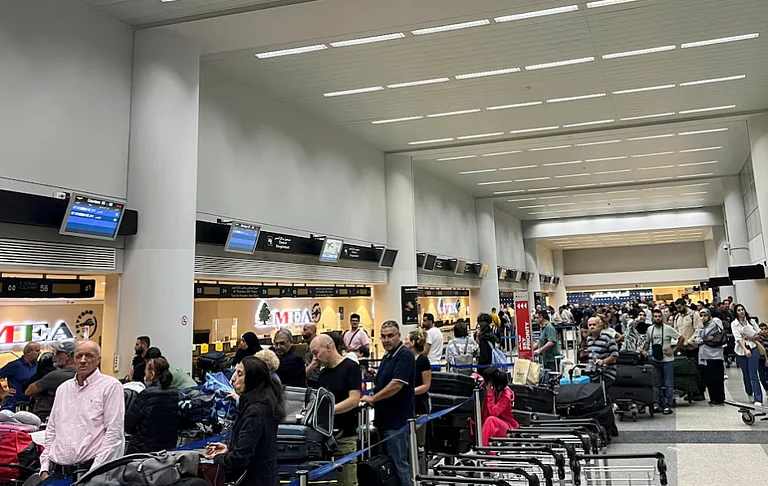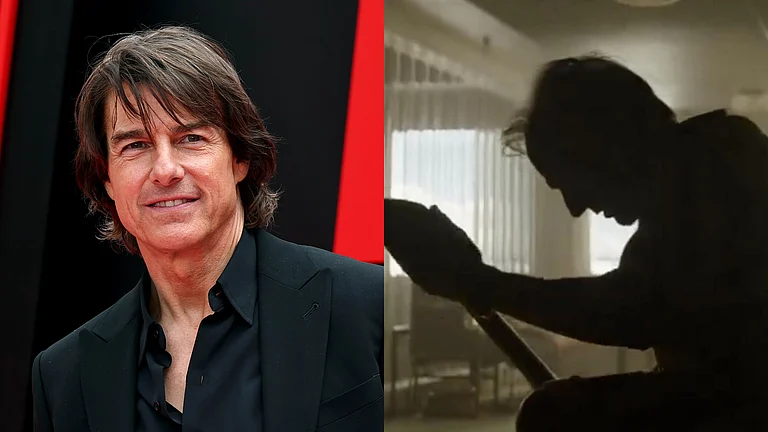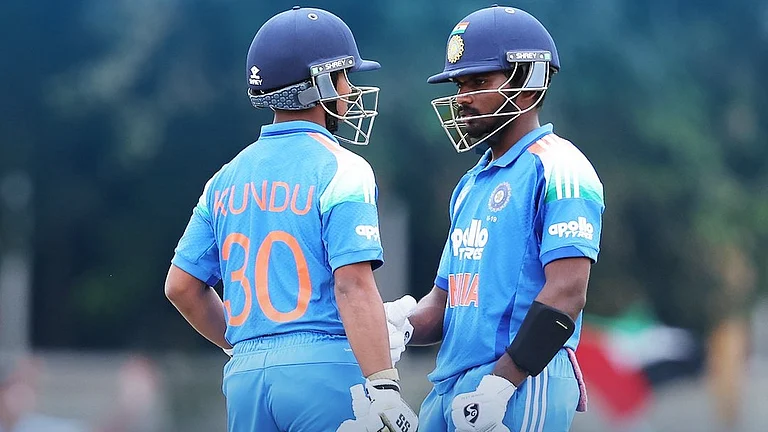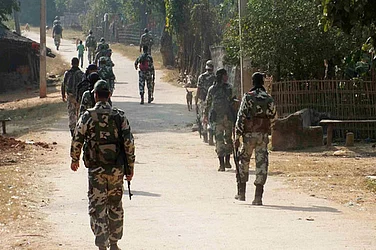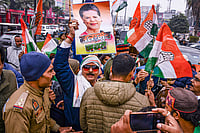The Bangladesh branch of theHUJI came into existence in 1992 after the Afghan Mujahideen captured power inKabul in April, 1992, after overthrowing the then Afghan President Najibullah.It was set up by a group of Bangladeshi nationals, who had fought against theforces of the Najibullah Government after having undergone jihadi training inPakistan. The formation of the HUJI (B) was announced at a pressconference in April 1992 by a group of Afghan war veterans. It wasprojected as a successor to a first Bangladeshi Mujahideen groupthat had been formed in 1984 by self-styled Commander Abdur Rahman, for fightingagainst the Soviet troops in Afghanistan. He later reportedly died in theAfghan War in 1989.
Among the founding fathers ofthe HUJI (B) were Shaikhul Hadith, Allama Azizul Haq, who is alsoassociated with the Islami Oikyo Jote (IOJ), a member of the former rulingcoalition headed by Begum Khalida Zia, Muhammad Habibur Rahman of Sylhet, AtaurRahman Khan of Kishoreganj, Sultan Jaok of Chittagong, Abdul Mannan of Faridpurand Habibullah of Noakhali. All of them are members of different Islamicorganisations and madrasas. Ataur Rahman Khan was reportedly elected to theParliament as a candidate of Begum Khalida Zia's
Bangladesh National Party (BNP) in 1991.
All of them visited Afghanistanin 1988 before the withdrawal of the Soviet troops and met, amongst others,Osama bin Laden. An account of their travel to Afghanistan at the invitation ofthe HUJI of Pakistan was given by Habibur Rahman in an interview to anIslamic journal called "Islami Biplob" (Islamic Revolution), which waspublished by the journal on August 20,1998. Habibur Rahman was also theconvenor of Sahaba Sainik Parishad and the founding principal of the JameyaMadania Islamia, a madrasa at Kazir Bazar, Sylhet.
He said in the interview:"An invitation from Harkat-ul Jihad- Al- Islami made it possible for me tomake the fortunate trip to Afghanistan... Those of us who visited the Afghanwar-fields during that trip were Shaikhul Hadith, Ataur Rahman Khan, Sultan Jaok,Abdul Mannan, Habibullah and myself. In Pakistan, leaders of the local chapterof the HUJI greeted us and took us to the HUJI Karachi office. HUJIPakistan chief Saifullah Akhtar and a Bangladeshi Mujahideen Abdur Rahman Shahiddrove us to an Afghan Mohajir ( refugee) camp on the Pakistan-Afghan border. Westayed at the camp and visited some injured Mujahideens and an Islamic cadetcollege, where the cadets received us with a guard of honour. Abdur Rahman thendrove us to the residence of top Mujahideen leader Rasul Siaaf. The housewas defended like a fort with anti-aircraft cannons and armed guards. Whilestill in Pakistan and on our way to Afghanistan, we visited a special Mujahideentraining camp and met about a dozen Bangladeshi young Mujahideens led by oneAbdul Quddus. We watched youths from different countries taking militarytraining on a mountainous terrain. The arms they were being trained to operateincluded rocket launchers. That night, I shared a meal of dry cold bread with ahandsome young Arab. When I inquired after his identity, I was told he wasOsama bin Laden, a son of one of the richest Saudi families. The next day,we entered Afghanistan and arrived at a Mujahideen cantonment on a mountain top.We visited an armoury inside a tunnel. We were informed that some Russian forceswere in position nearby and that every one must prepare to fight. All of us weregiven Kalashnikov (AK-47) rifles. We stayed the night at the camp, while aMujahideen team advanced towards the enemy position and engaged in a skirmish.The following day we started our return journey."
The HUJI (B) subsequentlyappointed as its leader Shawkat Osman alias Sheikh Farid. Imtiaz Quddus wasappointed its General Secretary. He is probably identical with Abdul Quddusmentioned above. It has its main operational base in the coastal area stretchingfrom the port city of Chittagong south through Cox's Bazar to the Myanmarborder. In addition to acts of terrorism, it has been involved in piracy,smuggling and gun-running . It reportedly maintains six training camps in thehilly areas of Chittagong and six more near Cox's Bazar. There are varyingreports of its total strength, going up to 15,000, but my own estimate on thebasis of available intelligence is that it has a hard-core strength of about700, consisting of native Bangladeshis, Rohingya Muslims from the Arakan area of Myanmar and Pattani Muslims from Southern Thailand. According to somereports, the Rohingya Muslims constitute the largest single group in theorganisation.
According to Bangladesh Policesources, a key suspect in the plot to assassinate the then Prime Minister,Sheikh Hasina, in July 2000, Mufti Abdul Hannan, was trained in a HUJIcamp in Peshawar in Pakistan. A diary recovered by the Police fromHannan's brother Matiur Rehman, who was also involved in the assassinationplot, reportedly indicated he was in touch with the Pakistani High Commission inDhaka.These sources say that Pakistan's Inter-Services Intelligence uses theHUJI (B) for running training camps for the insurgent groups in India'sNorth-East, for Indian Muslims and for selected members of the Bangladeshiillegal migrants to India. These training camps are reportedly located inthe Kurigram and Rangpur areas of Bangladesh, near the border of Coochbihar in West Bengal. The presence of similar training camps for training recruitsfrom India were also reported in the past in Rangmari, Sundermari and Masaldanga.
Instructors from the HUJI (B)are also attached to the training camps of the United Liberation Front of Assam(ULFA) near the Tirupura border. It was suspected that the attack on thesecurity guards outside the US Consulate at Kolkata in January, 2002, wasorchestrated by HUJI (B), in collaboration with the JEM and theLashkar-e-Toiba, under the name the Asif Reza Commando Force (ARCF). AftabAnsari alias Aftab Ahmed alias Farhan Malik, the prime accused in the attack,was in touch not only with the office-bearers of these organisations inPakistan, but also with Omar Sheikh, who had masterminded the kidnapping andmurder of Daniel Pearl. Omar Sheikh claimed during his interrogation bythe Karachi Police in 2002 that it was he who had asked Aftab Ansari tocarry out the attack.
The HUJI (B) reportedly receivesfinancial assistance from Pakistan, Saudi Arabia and Afghanistan through MuslimNon-Governmental Organisations (NGOs) of Bangladesh such as the Adarsa Kutir, Al Faruk Islamic Foundation and Hataddin as well as from the ISIthrough its station chief in the Pakistani High Commission in Dhaka. Amomg theterrorist incidents in Bangladesh in which it was suspected were: themurder of journalist Shamsur Rahman, on July 16, 2000, in Jessore, aplot to assassinate Sheikh Hasina on July 23, 2000, plots to assassinate 28 prominent intellectuals of Bangladesh , including National Professor KabirChoudhury, writer Taslima Nasreen and the Director General of the IslamicFoundation, Maulana Abdul Awal, an explosion at a Bengali New Year's Dayfunction in Dhaka on April 14, 2001, which killed eight people, an explosion ina Roman Catholic church at Baniachang in Gopalganj on June 3, 2001, killing 10worshippers, and an attempt to kill Dr.Humayun Azad, a Bangla Professor andfamous writer, on February 27, 2004.
In February, 2005, underpressure from the European Union, Begum Khalida Zia, the then Bangladesh PrimeMinister, who till then was denying the presence of any jihadi terroristorganisation in Bangladesh territory, admitted for the first time the presenceof the Jamiatul Mujahideen Bangladesh and the Jagrata Muslim JanataBangladesh and banned them. But her Government continued to deny the existenceof HUJI(B) and the ban order did not cover it.
Commenting on this in aneditorial on February 27, 2005, the usually reliable Daily Times ofLahore wrote as follows:
"The disease of ‘Islamistterrorism’ was incubated in Karachi and Khost and then passed on to Dhaka. Aglance at the looking glass in Dhaka will discover Pakistani-jihadi footstepsall over the place. The Harkatul Mujahideen (Jihad) al-Islami (the one calledHUJI in Bangladesh) is the outfit whose leader was a graduate of the BanuriMosque seminary in Karachi and whose activists tried to kill our Prime MinisterShaukat Aziz recently. HUJI is the international face of the Taliban and AlQaeda. As for the "pseudo-Islamic" nature of what is happening inBangladesh, let us accept that that is the way of ‘Islamic revolution’ thesedays. This is what the Uzbek Islamist Tahir Yuldashev did in Osh before he camedown to Afghanistan and then to Pakistan’s Tribal Areas. The Hizb al-Tahrir,which Pakistan banned only after Yuldashev’s discovery, worked in tandem withhim in Central Asia and is now clearly working in tandem with HUJI inBangladesh. As in Pakistan, seminaries also flourish in Bangladesh with foreignfunding because of poverty and — and this few observers mention — profits tothe organising clergy. Had the clergy been devoted to a higher cause they wouldhave used the money to promote local Islam and not the hardline Wahhabi-Saudione now associated with the Taliban. An increasing number of Bangladesh’smadrassas are now following the pattern of study of the madrassas in Pakistanand have become Deobandi in their world view. The Hindus have been targeted,aided by the widespread belief that they should be expelled from the country.The jihad in Afghanistan brought in Al Qaeda money, and the training camps inBangladesh have since begun to turn out warriors for the Taliban and Al Qaeda."
The paper added:
"The phase Bangladesh ispassing through can be taken in two parts. An aspect of it belongs to the early1990s when the "Islamist" outfits in Pakistan did not offend theconservative Muslim League but were seen as a threat by a liberal PPP (PakistanPeople's Party). These days the ruling BNP in Bangladesh is most reluctant totake action against the Islamists as they continue to attack Awami League cadresand communists; but when phase two opens up, the BNP will be equally threatened.The "purifying" dynamic of the Islamists will demand that the BNP bend tothe kind of shariah the warriors favour in light of their training inAfghanistan and their "salafi" contact with Al Qaeda. A day will come soonenough when the state of Bangladesh will come under threat from the Islamicwarriors it is now
empowering through denial."
As predicted by the paper, thatday came on August 17,2005, when the two organisations banned in February, 2005,but whose leaders and activists were not arrested, carried out 450 simultaneousexplosions all over Bangladesh and thereafter introduced suicide terrorism. Acting in panic, Begum Khalida Zia ordered a round-up of the leaders andactivists of these two organisations and their prosecution. She also banned theHUJI (B) in October, 2005, but none of the leaders of HUJI (B)except Mufti Abdul Mannan, who was involved in the attempt to kill Sheikh Hasina,was arrested. Its cadres, many of them trained in Pakistan, remain untouched andno action has been taken against its training infrastructure in Bangladeshterritory, which continues to train jihadi terrorist recruits from India,Myanmar
and southern Thailand.
The HUJI of Pakistan is a member of bin Laden's International Islamic Front (IIF) for Jihad Against theCrusaders and the Jewish People formed in 1998 and through its branch inBangladesh, it has been trying to arabise and wahabise the Muslims ofBangladesh, who are in their overwhelming majority descendents of converts fromHinduism, and use them for carrying out its pan-Islamic agenda in India,Bangladesh, Myanmar and southern Thailand.







